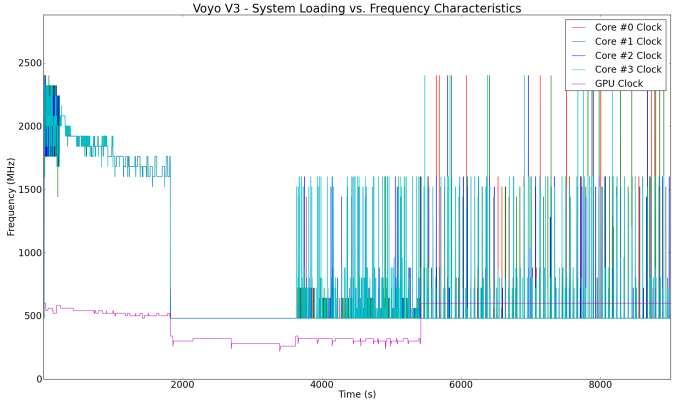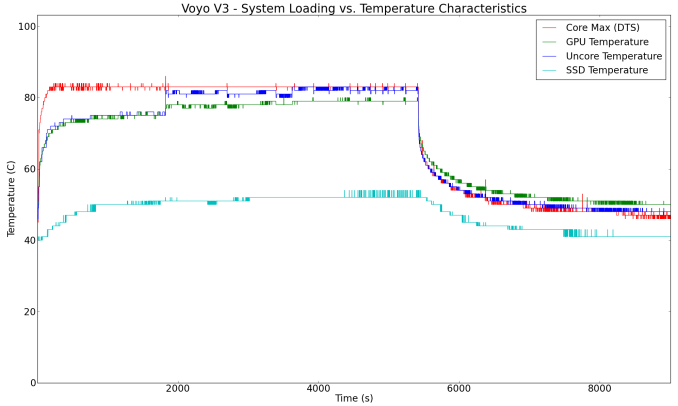Voyo V3 Review - A Fanless Intel Atom x7-Z8700 (Cherry Trail) mini-PC
by Ganesh T S on March 1, 2016 8:00 AM EST- Posted in
- Systems
- Intel
- Atom
- Passive Cooling
- Mini-PC
- Cherry Trail
Power Consumption and Thermal Performance
The power consumption at the wall was measured with a 1080p display being driven through the HDMI port. In the graphs below, we compare the idle and load power of the Voyo V3 with other low power PCs evaluated before. For load power consumption, we ran Furmark 1.12.0 and Prime95 v27.9 together. Given that the BIOS of the machine is not really optimized, the idle power being more than most comparable PCs is not surprising.


The load power consumption numbers can also be easily explained. The Atom x7-Z8700 has a SDP of only 2W, and it is definitely less power hungry compared to the Intel Celeron N3000 in the ASRock Beebox. However, it does lose out to the Bay Trail Compute Stick - this could be due to the power consumption of the extra components on the board such as the PCIe - SATA bridge and the faster clocks in the Cherry Trail SoC.
Our thermal stress routine starts with the system at idle, followed by 30 minutes of pure CPU loading. This is followed by another 30 minutes of both CPU and GPU being loaded simultaneously. After this, the CPU load gets removed, allowing the GPU to be loaded alone for another 30 minutes. The various clocks in the system as well as the temperatures within the unit are presented below.
The core clocks briefly operate at the maximum turbo frequency (2.4 GHz), but gradually scale down to the base clock (1.6 GHz) as the load is sustained. Thankfully, the thermal solution is decent enough to prevent the SoC from throttling. The GPU clock measurement has the usual Intel 'bug' where the measured clock is the maximum clock rate even when the GPU is not loaded. As soon as the GPU starts getting loaded, it moves between 200 - 300 MHz while keeping the power consumption of the whole system around 10 W.
According to the official specifications, the junction temperature of the Atom x7-Z8700 is 90C. Fortunately, after enabling DTS in the BIOS, we find that the maximum temperature of any of the board components is kept below 85C even under extreme stress.
Another important aspect to keep note of while evaluating fanless PCs is the chassis temperature. Using the Android version of the FLIR One thermal imager, we observed the chassis temperature after the CPU package temperature reached the steady state value in the above graph. Note that the picture below was taken after manually turning up the operating unit to expose the underside (metallic part abutting the black thermal film which covers the main board components).
We have additional thermal images in the gallery below.
The good part here is that even under extreme stress, the chassis doesn't heat up beyond 50 C. The bad part is that a lot of performance is left on the table (in terms of allowing the SoC to sustain turbo clocks for a longer duration) due to inefficient thermal design. Allowing for the metallic segment to be on top to aid convective cooling would have definitely helped in making the thermal performance better.



















69 Comments
View All Comments
ragenalien - Tuesday, March 1, 2016 - link
Is the wireless card replaceable.ganeshts - Tuesday, March 1, 2016 - link
The wireless card communicates via SDIO and is soldered to the board.ganeshts - Tuesday, March 1, 2016 - link
You can actually check out the board layout here: http://www.cnx-software.com/wp-content/uploads/201...The WLAN card is on the top right (where the black antenna pigtail comes out from), and you can see that it is indeed not replaceable.
Coelispex - Sunday, April 3, 2016 - link
Hi Ganeshts,If we use a 802.11ac USB adapter, would it work for the Voyo V3?
Ratman6161 - Tuesday, March 1, 2016 - link
I can't get past the Warez OS issue. If I wanted such a device with Windows on it, it better be a legally installed copy. The idea that I would need to go out and get my own copy means you have to add $100 to the price in order to get it leagal for what it was supposed to come with out of the box.ganeshts - Tuesday, March 1, 2016 - link
I don't think Microsoft allows for 'cheap' licenses if the hardware specs are as good as the Voyo V3.. particularly, I believe the cheap license is available only for the x86 version, not x64. Also, the RAM has to be 2GB or lesser (IIRC).Anyways, the cost for the Windows license is an issue with any PC that doesn't have neutered hardware specifications.
Slawek - Tuesday, March 1, 2016 - link
What are results of Google Octane and Mozilla Kraken? If am going to use it for web browsing these are the most important benchmarks to know.ganeshts - Tuesday, March 1, 2016 - link
Web browsing is a major part of the PCMark 8 benchmarks - and those scores make it clear that this unit is better than other passively cooled Braswell PCs.Usually, we don't present web browser benchmarks for mini-PCs because they vary widely with the browser used and also updates to the browsers themselves - making it difficult to go back and compare against older units. It is a different case for more 'closed' systems such as tablets and smartphones. Because of this, we believe that the PCMark 8 browser tests (with their standardized browser engine) are more indicative of performance that users can get at any given point of time.
Slawek - Tuesday, March 1, 2016 - link
On my laptop difference between the latest Firefox, Chrome and Safari is within 5%, this is precise enough tool that tells me about system performance. Both Octane and Kraken are easy to execute. I can walk up to Microsoft or Apple store and in less than a minute I can compare which computer is faster.ganeshts - Tuesday, March 1, 2016 - link
Can you tell me what is the difference between Firefox 30 and Firefox 44 ? I can't go back and power up every single PC reviewed before to rerun those benchmarks every time the browser version changes.I prefer a standardized browsing engine, and that is what PCMark 8 provides.
It is nice to have quick scores to compare against what you already have, but it doesn't hold up under detailed scrutiny - we need repeatable and reproducible benchmarks for different use-cases.